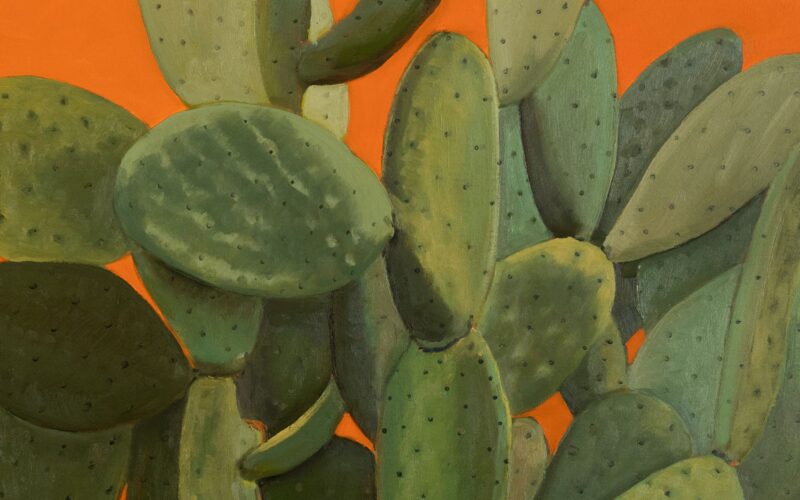Times2 talks to the artist to find out more.
Eric Kaiser’s body of work currently on display at MUŻA was initiated shortly after the artist’s arrival in Malta at the end of 2022 and was completed in February 2024. In the meantime, he participated in the Archive group exhibition organised by the Malta Society of Arts in September 2023.
However, Smuggler, curated by Charlene Vella, marks his first solo exhibition in Malta, made possible through MUŻA’s open call for proposals, which he came across on Facebook in early 2023.
Why have you chosen to call the exhibition Smuggler?
The title Smuggler operates on several conceptual levels. Metaphorically, the prickly pear cactus − central to the exhibition − is itself a “smuggled” entity, as it is not native to Malta. Artistically, I “smuggle” new meanings into classical artworks by overlaying them with contemporary symbols, such as the cactus. On a personal level, as a foreign artist integrating into Maltese society, I inevitably bring my own cultural lens into a new context, subtly merging and embedding my perspective − much like a smuggler of ideas.

What is it about the prickly pear that particularly appeals to you?
Coming from Northern Europe, the prickly pear was completely foreign to me. During my early explorations around Malta, I was struck by the scarcity of trees and the abundance of these cactus forms. I became fascinated by their organic structure − growing unpredictably from one cladode to the next without a fixed logic. That lack of pattern mirrors my own creative process, where ideas evolve intuitively, one leading to another without a predetermined direction.
In many ways, I identify with the cactus as an outsider finding its place in a new environment. Living in Balzan − a traditional Maltese village − has given me an opportunity to observe and engage with the local way of life. Like the cactus, I exist somewhat on the periphery, away from the island’s urban centres, surrounded by limestone and heritage. This setting allows for a slower, more reflective mode of existence and artistic creation.

What do your still life paintings represent?
My cactus still life paintings began as a form of personal archiving − a way to document and reflect on my surroundings in the absence of a larger artistic project. Initially, they were simple studies, but the applied motif of the prickly pear onto the canvas gradually transformed them into a coherent series. By juxtaposing the cactus with mundane objects − shoes, food, cleaning products− I playfully elevate the ordinary. The aim is to challenge conventional expectations of still life and imbue everyday items with unexpected significance. For Maltese viewers, it may also offer a renewed appreciation of the cactus, a familiar shape perhaps often overlooked.
The Cactus Still Life – Religious Series evolved naturally from the process I mentioned earlier − an organic, almost spontaneous progression, much like the way the cactus grows.
Immersed in Malta’s rich religious iconography, I began drawing compositional inspiration from classical religious paintings. For example, in a reinterpretation of Fra Angelico’s Annunciation, a bottle of window cleaner takes the place of the Angel Gabriel, while a bleach container echoes the Virgin Mary’s figure.
Similarly, for Pontormo’s Visitation, I replaced the central figures with bottles of household products, maintaining the original postures. The cactus motif continues to overlay the compositions, linking them visually and conceptually. I hope the viewer enjoys the visual play and the unexpected resonance between the sacred and the banal.
But we could also read these paintings as a commentary on how contemporary life blends materialism with tradition. The festas of today have opened a wide space to consumerism that tends to overshadow the spiritual values.

I was also truly honoured to be invited to engage in dialogue with selected works from MUŻA’s collection. For pieces by artists such as Tommaso Minardi and Matthias Stom, I applied a similar strategy as in the religious still life series − recasting entire compositions using contemporary objects. However, with works by Stefano Erardi and Antonio Barrera, I shifted focus, drawing on specific details rather than direct substitutions. This approach marked a new direction, leading to a sub-series I’ve titled Cactus Portraits and Art History, which explores reinterpretation on a more intimate, fragmentary level.
And any last thoughts?
Looking back, what excites me most about this body of work is how it traces the evolution of a simple idea into an expansive visual narrative. The exhibition comprises over 50 pieces and offers a glimpse into my creative process − how one motif, like the cactus, can proliferate and mutate across different forms and concepts.
Smuggler by Erik Kaiser, curated by Professor Charlene Vella, runs at MUŻA from June 20 – July 27










